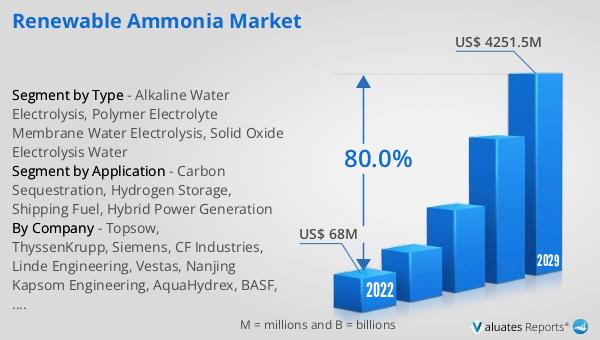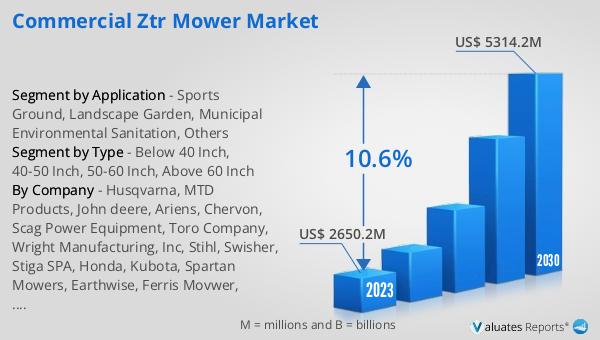What is Global Renewable Ammonia Market?
The Global Renewable Ammonia Market is an emerging sector focused on producing ammonia using renewable energy sources instead of traditional fossil fuels. Ammonia, a compound of nitrogen and hydrogen, is primarily used in fertilizers, but its potential applications are expanding due to its ability to store and transport energy. Renewable ammonia is produced through processes that utilize renewable energy, such as wind, solar, or hydropower, to generate hydrogen, which is then combined with nitrogen from the air. This approach significantly reduces carbon emissions compared to conventional ammonia production methods, which rely heavily on natural gas. As the world shifts towards sustainable energy solutions, the demand for renewable ammonia is expected to grow, driven by its potential to decarbonize various industries, including agriculture, energy, and transportation. The market is also supported by increasing governmental and corporate commitments to reduce carbon footprints and achieve net-zero emissions. As a result, the Global Renewable Ammonia Market is poised to play a crucial role in the transition to a more sustainable and environmentally friendly global economy.

Alkaline Water Electrolysis, Polymer Electrolyte Membrane Water Electrolysis, Solid Oxide Electrolysis Water in the Global Renewable Ammonia Market:
Alkaline Water Electrolysis, Polymer Electrolyte Membrane (PEM) Water Electrolysis, and Solid Oxide Electrolysis are three key technologies used in the production of renewable ammonia, each with distinct characteristics and applications. Alkaline Water Electrolysis is one of the oldest and most established methods for hydrogen production. It operates by passing an electric current through water, causing it to split into hydrogen and oxygen. This process uses an alkaline electrolyte, typically potassium hydroxide, and is known for its reliability and cost-effectiveness. However, it requires relatively large equipment and operates at lower current densities, which can limit its efficiency compared to newer technologies. Polymer Electrolyte Membrane Water Electrolysis, on the other hand, uses a solid polymer as an electrolyte. This method is known for its high efficiency and ability to operate at higher current densities, making it suitable for applications where space and weight are critical factors. PEM electrolysis systems are compact and can quickly respond to changes in electricity supply, making them ideal for integration with renewable energy sources like wind and solar power. However, the technology is currently more expensive than alkaline electrolysis due to the cost of materials used in the membranes and catalysts. Solid Oxide Electrolysis is a high-temperature process that uses a solid oxide or ceramic electrolyte to produce hydrogen. This method operates at temperatures between 700°C and 1,000°C, which allows it to achieve high efficiencies by utilizing waste heat from other industrial processes. Solid Oxide Electrolysis is particularly attractive for large-scale hydrogen production and can be integrated with industrial facilities to improve overall energy efficiency. However, the high operating temperatures require materials that can withstand such conditions, which can increase the cost and complexity of the system. In the context of the Global Renewable Ammonia Market, these electrolysis technologies are crucial for producing green hydrogen, a key component of renewable ammonia. As the demand for sustainable energy solutions grows, advancements in these technologies are expected to enhance the efficiency and cost-effectiveness of renewable ammonia production, further driving the market's expansion. Each technology offers unique advantages and challenges, and their development will play a significant role in shaping the future of the renewable ammonia industry.
Carbon Sequestration, Hydrogen Storage, Shipping Fuel, Hybrid Power Generation in the Global Renewable Ammonia Market:
The Global Renewable Ammonia Market finds its usage in several innovative areas, including carbon sequestration, hydrogen storage, shipping fuel, and hybrid power generation. In carbon sequestration, renewable ammonia plays a role in reducing greenhouse gas emissions by providing a low-carbon alternative to traditional ammonia production methods. By utilizing renewable energy sources, the production of ammonia can significantly lower its carbon footprint, contributing to global efforts to mitigate climate change. Additionally, ammonia can be used in carbon capture and storage (CCS) technologies, where it helps in capturing carbon dioxide emissions from industrial processes and storing them underground or utilizing them in other applications. In hydrogen storage, renewable ammonia serves as an efficient medium for storing and transporting hydrogen. Ammonia can be easily liquefied and stored at relatively low pressures, making it a practical option for hydrogen storage. When needed, ammonia can be decomposed to release hydrogen, which can then be used as a clean energy source. This capability makes renewable ammonia an attractive solution for overcoming the challenges associated with hydrogen storage and distribution, particularly in regions with limited infrastructure. As a shipping fuel, renewable ammonia offers a promising alternative to conventional marine fuels, which are major contributors to air pollution and greenhouse gas emissions. Ammonia can be used in internal combustion engines or fuel cells to power ships, providing a zero-emission solution for the maritime industry. The use of renewable ammonia as a shipping fuel aligns with the International Maritime Organization's goals to reduce greenhouse gas emissions from ships and transition to more sustainable energy sources. In hybrid power generation, renewable ammonia can be used in combination with other renewable energy sources, such as wind or solar, to provide a stable and reliable power supply. Ammonia can be stored and used to generate electricity during periods of low renewable energy production, ensuring a continuous power supply. This capability makes renewable ammonia an essential component of hybrid power systems, which aim to maximize the use of renewable energy while minimizing reliance on fossil fuels. Overall, the Global Renewable Ammonia Market is poised to play a significant role in advancing sustainable energy solutions across various sectors, contributing to a cleaner and more sustainable future.
Global Renewable Ammonia Market Outlook:
The global market for renewable ammonia is experiencing significant growth, with its value estimated at $215 million in 2024. This market is projected to expand dramatically, reaching an impressive size of $12,580 million by 2031. This growth represents a remarkable compound annual growth rate (CAGR) of 80.0% over the forecast period. This rapid expansion is driven by increasing demand for sustainable and environmentally friendly energy solutions, as well as growing awareness of the need to reduce carbon emissions. Renewable ammonia offers a viable alternative to traditional ammonia production methods, which rely heavily on fossil fuels and contribute to greenhouse gas emissions. By utilizing renewable energy sources, such as wind, solar, and hydropower, the production of ammonia can be significantly decarbonized, aligning with global efforts to combat climate change. The market's growth is also supported by governmental and corporate commitments to achieve net-zero emissions and transition to a more sustainable energy future. As a result, the Global Renewable Ammonia Market is expected to play a crucial role in the transition to a low-carbon economy, providing a sustainable solution for various industries, including agriculture, energy, and transportation. The impressive growth rate of the market highlights the increasing importance of renewable ammonia in the global energy landscape and its potential to drive significant environmental and economic benefits.
| Report Metric | Details |
| Report Name | Renewable Ammonia Market |
| Accounted market size in year | US$ 215 million |
| Forecasted market size in 2031 | US$ 12580 million |
| CAGR | 80.0% |
| Base Year | year |
| Forecasted years | 2025 - 2031 |
| by Type |
|
| by Application |
|
| Production by Region |
|
| Consumption by Region |
|
| By Company | Topsow, ThyssenKrupp, Siemens, CF Industries, Linde Engineering, Vestas, Nanjing Kapsom Engineering, AquaHydrex, BASF, Cummins Inc., Enapter Srl, ENGIE SA, Greenfield Nitrogen, Hiringa Energy Ltd, ITM Power plc |
| Forecast units | USD million in value |
| Report coverage | Revenue and volume forecast, company share, competitive landscape, growth factors and trends |
